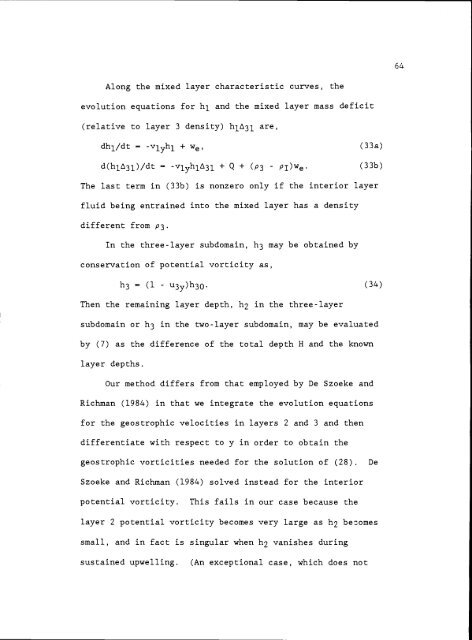Observations and Modelling of Fronts and Frontogenesis
Observations and Modelling of Fronts and Frontogenesis
Observations and Modelling of Fronts and Frontogenesis
You also want an ePaper? Increase the reach of your titles
YUMPU automatically turns print PDFs into web optimized ePapers that Google loves.
Along the mixed layer characteristic curves, the<br />
evolution equations for h1 <strong>and</strong> the mixed layer mass deficit<br />
(relative to layer 3 density) h131 are,<br />
dh1/dt - vlyhl + We,<br />
(33a)<br />
d(h1i31)/dt = -vlyhlL3l Q + (P3 PI)We. (33b)<br />
The last term in (33b) is nonzero only if the interior layer<br />
fluid being entrained into the mixed layer has a density<br />
different from p.<br />
In the three-layer subdomain, h3 may be obtained by<br />
conservation <strong>of</strong> potential vorticity as,<br />
(1 u3y)h3o. (34)<br />
Then the remaining layer depth, h2 in the three-layer<br />
subdomain or h3 in the two-layer subdomain, may be evaluated<br />
by (7) as the difference <strong>of</strong> the total depth H <strong>and</strong> the known<br />
layer depths.<br />
Our method differs from that employed by De Szoeke <strong>and</strong><br />
Richman (1984) in that we integrate the evolution equations<br />
for the geostrophic velocities in layers 2 <strong>and</strong> 3 <strong>and</strong> then<br />
differentiate with respect to y in order to obtain the<br />
geostrophic vorticities needed for the solution <strong>of</strong> (28). De<br />
Szoeke <strong>and</strong> Richman (1984) solved instead for the interior<br />
potential vorticity. This fails in our case because the<br />
layer 2 potential vorticity becomes very large as h2 becomes<br />
small, <strong>and</strong> in fact is singular when h2 vanishes during<br />
sustained upwelling. (An exceptional case, which does not<br />
64















